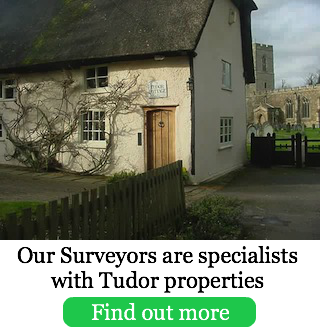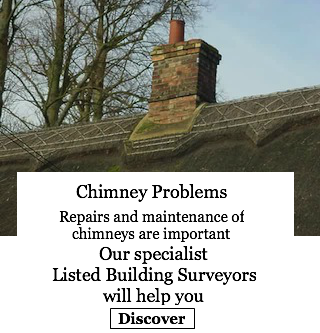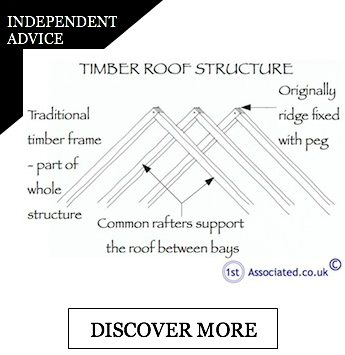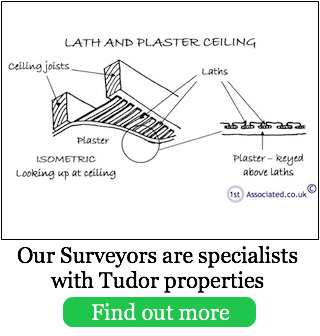Tudor Listed Property Common Problems 
This article specifically looks at traditional Tudor timber framed properties and their associated problems.
We would advise that the property problems can be very specific to the area and location of the property, or even the direction it is facing, i.e. north, south, east or west elevations can each have their individual problems. The defects and problems also relate to the mixture of building materials used, this can range from small repairs to where alterations and extensions have been carried out, and, of course, the age and general standard of the original construction and any additional maintenance that has taken place on taken place on the property. Having said all of that we have given you a general indication of the typical problems that traditional Tudor timber framed properties have, which we hope will be a useful free guide.

Interestingly, timber frame properties do not necessarily enable you to see the timber frame. The timber frame can be hidden with the render, hopefully, a parjeting lime based render, as opposed to a modern cement based render. There are several cases where Surveyors have been sued where they have not identified the problems of a cement based render on a timber frame and how it can accelerate rot, particularly if it hasn’t got any details, such as a bell mouth detail to the base. This is why it is essential to ensure that the Surveyor you book has expertise in this area which all our Listed Building Surveyor have matched with many years of surveying such buildings.
Getting back to what they look like, they are fairly rectangular and low. Many of them wouldn’t have had a first floor and this has been added at a later date. Then you find you will get rooms in the roof, often known as eyebrow roofs. The traditional view of a timber frame building is a black and white timber structure, often box frame, where you can see the square boxes of the timber and also the relatively tall, triangular crucks frame properties.

![]()
When considering high level problems to a Tudor timber frame property it means that scaffolding is likely to be required or some form of access platform, be it from a cherry picker or hoist. This can often be where the main costs are when carrying out a project, as health and safety requirements on a building project which is of the upmost importance.
![]()
Chimneys were added after the original construction, in most cases, with the original chimney being, literally, a hole in the roof, or in the gable ends of the property, depending upon the type of property. A chimney was very much a modern accessory. The adding of a chimney can sometimes be an issue (has been an issue for many years) with rainwater getting in where the chimney joins the main roof and general spalling of brickwork, particularly where a soft red brick has been used or where a cement mortar has been wrongly used for repointing. We have also found that aerials fixed by wires, or screw fixed, can cause point loading and lead to deterioration of the chimney.

![]()
Originally Tudor properties were thatched roofed buildings. Many of the roofs you will find on a Tudor property have been added later. Thatch is generally a resilient material, as long as it is well maintained with wire mesh to hinder the birds from using it or for collecting nesting material. Common roof materials are straw and reed, it used to be known as Norfolk reed.
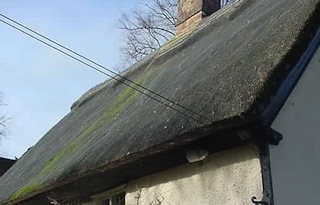

The older style clay tiles will have been held on with wooden pegs, originally oak. These have generally deteriorated over the years, as often as the clay tile, which was originally handmade, and tend to be softer. On Listed buildings these tiles are required to remain.
The problems with matching clay tiles
This is always a difficult one, as in years gone by, systems of matching older clay tiles meant that there was a very good trade in second hand, sometimes stolen, tiles. This resulted in it not being as stringent a requirement on the rarer properties, but sometimes this doesn’t look very pretty.

Often people advise us that their timbers within their period timber property are rounded. This is because originally they would literally have used trunks from trees and then quartered them for use to build the timber frame property.
The problems that our Independent Listed Building Surveyors typically find are woodworm, although we have to add that usually the woodworm is not active and we are coming across cases where it has been treated many, many times, even though it isn’t active. We would just comment that it takes a vast amount of woodworm to actually make an older style roof timber structurally unsound. There can also be wet rot and there is a possibility of dry rot, although it is relatively rare.

Thatched roofs will not have a fascia or soffits, due to the way the thatch overhangs the building. Thatched roofs also do not need gutters and downpipes. Thatched roofs make a great insulation and sunshade, depending upon the time of year, we would add, and the depth of insulation, of course, and how well maintained it is. Wet thatch, of course, does not make good insulation, it is the air in the thatch that causes the good insulation and this goes when the straw or reed gets wet and mulches together and compresses.

We do find, what is termed as, exposed rafter feet in the older properties. These can be very awkward to decorate. They are simply the ends of the rafters that form the pitch of the roof. They actually make normal fascias and soffits look relatively easy to decorate in comparison!


A variety of timber frame constructions were used, from the cruck frame to box frame. The varieties depended upon the area and the era. Our specialist Surveyors always consider the timber framework in two categories: the structural frame and the primary timbers and then the infill timbers being the secondary timbers.

A variety of infill materials have been used in most timber frame buildings; from the earlier use of wattle and daub with a parjeting plaster, which was a lime based plaster, often with horse or oxen hair (there were many horses around in those days) and in more recent times (by recent we mean in the last few hundred years) brick infill panels have sometimes been used, sometimes in a herringbone pattern for a decorative finish. Many times an older property was rendered over, but also the timbers were left exposed. We think they were not left as exposed as frequently people have the impression, certainly they weren’t black and white, which is often associated with Tudor properties, as this, interestingly enough, was a fashion that the Victorians developed. The original parjeting render colours would have been more natural, being made up from plants, such as saffron that forms the yellows that is often used as a render in Suffolk and Norfolk, or animal products. Being Eco-friendly is a modern term but looking at the history of buildings using local sourced materials was common in the building of homes.
In some areas of the country weather boarding was a common cladding to timber frame properties, for example, the Essex area.
What is wattle and daub?
Wattle and daub is a building material used for making walls, within which wooden strips are woven. These are usually bound together with straw, animal dung, sand, clay and soil.
What is weather boarding?
Weather boarding is a timber boarding, also known as shiplap boarding, offers a protective covering to the timber frame and therefore needs to be well maintained. It was commonly used in the Essex areas, as well as parjecting or decorative plastering.

The sole plates are at the very bottom of the structure and the wall plates are at the very top of the structure, just before the roof. In both cases they can be susceptible to rot, be it wet rot, which in turn can cause woodworm, as this is the sort of environment they like. It is very important that these are checked when you are buying a property by a building surveyor, that specialises in this type of construction.


Tudor property floors would originally have been earth, possibly with a lime mix to harden it, sometimes with tiles added.

Foundations will be minimal, normally built on ground level. In some cases, although we believe it is rare, timber piles will have been used, typically timber forced straight into the ground vertically to build from.
We have also included wall plates, or sole plates, as they are known, as being a foundation, as the surviving Tudor buildings tend to have a plinth of brickwork or stone, to which a timber wall, or sole plate, is added. These can suffer from deterioration from dampness. Over the years we have seen timber in very bad condition, but unfortunately we have seen the pollution causing more problems. You have to fully understand how the structures work to correctly diagnose how to resolve the problems which is why engaging the services of our Listed Building Surveyors will help you understand what is required.

In Tudor buildings predominantly lath and plaster will have been originally used, there may be some boarding. Today, most modern refurbished sections will have been replaced with plasterboard. The use of these different materials can lead to cracking, though of course it can be much worse if it is structural cracking. This needs to be correctly diagnosed.

During the Tudor era buildings were built in many shapes and sizes. The smaller building, in particular, tends to have always been extended on. This can cause problems when the original property is obviously timber and the modern extension could be in brickwork or stonework, which acts, and reacts, completely differently. This combination of different property styles is where the real skill of building surveying comes in, to establish whether they work well together, or, it is probably more correct to say, if they work acceptably together. Many times with older properties we find the original construction is good and sound, assuming it has been well maintained, it is the additions that have been added over the years that are the problem and no doubt we are still making mistakes on properties today.
Having a specialist Listed Building Surveyor give guidance and advice is essential if you are considering making amendments to your Tudor Listed property. Free phone 0800 298 5424 today for independent expert advice.

